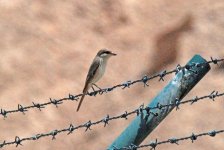Hi Harry,
I was basing my ID on the grey-brown upperparts, rather clean white underparts (apart from the wash on the flanks already mentioned), black mask, pinkish, dark-tipped bill and faint chevrons on the underparts. Looking again, I don't feel anything like as confident. I agree the super isn't very distinct, and looking again, the upperparts look sandier than before. A black mask is also fine for isabellinus. The faint barring on the underparts may indicate a 1st summer bird. I also remember reading in the Dutch Birding article that phoenicuroides should not show an apricot wash on the flanks. Re the warmly-coloured crown, I think the crown should be concolorous with the upperparts on female phoenicuroides.
You do get difficult individuals in the Gulf. I remember at least two individuals one day last autumn which I couldn't assign to either species. I remember Peter posting images of much easier birds previously.
As for timing, phoenicuroides are definitely passing through at the moment and are perhaps more common than isabellinus, although, as you rightly point out, they're rare in winter, when isabellinus is common.






